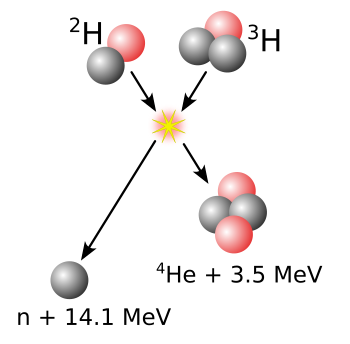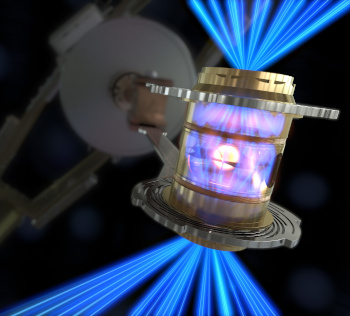Nuclear Fusion Energy
February 13, 2023
In the early
1990s, several of my
colleagues were doing
research on a
laser sensing system for the
International Thermonuclear Experimental Reactor (ITER), a large
tokamak magnetic confinement nuclear fusion reactor. ITER is an international
collaboration intended to become the largest of more than a hundred fusion reactors built since the
1950s, and at 22 billion
dollars it's the
most expensive science experiment of all time, exceeding even the
cost of the
Large Hadrian Collider. I mention this as an illustration that serious attempts at nuclear fusion
energy have been ongoing for many
decades.

What could be easier? Fuse deuterium (2H) nuclei and tritium (3H) nuclei to create helium (4He) and a lot of energy.
The essential problem is the large activation energy of nuclear reaction. Deuterium and tritium will only fuse at temperatures of about 100 million degrees Celsius.
Our Sun and other stars, which are giant fusion reactors, produce these temperatures by gravitational forces.
(Modified Wikimedia Commons image. Click for larger image.)
Hans Bethe's 1939
theory of
stellar energy production established the basic mechanism for fusion energy production in stars. Theory is one thing, but confirmation is another. That's the reason why Bethe's
Nobel Prize in Physics wasn't awarded until 28 years later, in 1967.
Frederick Reines (1918-1998) was awarded the Nobel Prize in Physics in 1995 for his
1956 experiment with
Clyde Cowan (1919-1974) that confirmed the existence of
neutrinos. That's a gap of 39 years that denied Cowan a share in the prize since the Nobel Prize is never
awarded posthumously.
Before the basic structure of the
atomic nucleus was elucidated in the
1930s, leading to Bethe's theory,
scientists wrestled with the problem of solar energy production. According to
Maslow's law of the instrument,
If the only thing you have is a hammer, everything looks like a nail; so,
19th century scientists used the
physical principles known at their time for an explanation. Their
speculations are discussed in a
paper by the ever-enlightening
Helge Kragh (b. 1944).[1]
One such theory was the
idea that the Sun's energy was a consequence of an
infall of
asteroids. This theory was supported by the idea that the
heat developed by an asteroid would be about 10,000 times greater per unit
mass than the very energetic
chemical reaction of
oxygen and
hydrogen to form
water.[1] A problem with this concept is that it would require an annual infall of about 100
Earth masses, something that would shorten the
sidereal year by about half a
second. This was not observed, and such a dense cloud of asteroids would affect the
orbits of
Mercury and
comets.
A similar
mechanical theory proposed by the
discoverer of the
electron,
J.J. Thomson (1856-1940), and others, supposed that a
gravitational contraction of the Sun was the source of its heat. This
model predicted a long Solar lifetime of 100-500 million years. but still too short to account for the
geological history of the Earth.[1] There was also the strange idea that the Sun's
radiant energy might return to it after a long
cosmic journey in a
non-Euclidean universe.[1]
In 1903,
Marie Curie (1867-1934) and her
rassistant, Albert Laborde, reported that
radium disintegration generated about 100
calories per
gram per
hour, which is about 200,000 times greater than for
coal combustion.[1]
Ernest Rutherford (1871-1937) calculated that just 2.5
ppm of radium in the Sun would account for its energy emission.[1]
Helium is a product of radium disintegration, and there's a lot of helium in the Sun. However, the
half-life of
radium isotopes is too short, and radium was never detected in the Sun.
The big fusion energy news at end of 2022 was from
Lawrence Livermore National Laboratory's National Ignition Facility (NIF), which announced on December 14, 2022, that
scientific energy breakeven was achieved for the first time in a nuclear fusion
experiment on December 5, 2022.[2-5] Breakeven means that the experiment produced more energy from fusion than the energy needed to create it.[2] In this case, the energy used was from a tremendously large
array of 192
lasers focused on a small
specimen of
deuterium and
tritium.[2-3]

The frozen specimen of deuterium and tritium is contained within a cavity called a hohlraum, a German word for a "hollow space."
The incident ultraviolet radiation from the lasers is converted into X-rays inside the hohlraum, and this radiation compresses the isotope mixture into a high temperature plasma.[2]
(Portion of a Lawrence Livermore National Laboratory image. Click for larger image.)
The NIF approach is known as
inertial confinement fusion in which the lasers create
shock waves that
compress pinhead-sized spherical specimens of a few
milligrams of deuterium and tritium. More likely to be
commercialized is
Magnetic confinement fusion in which
magnetic fields are used to confine a heated
plasma reaching fusion initiation temperature. Around
1940,
Arthur Kantrowitz (1913-2008) and
Eastman Jacobs (1902–1987) were the first to build a magnetic confinement fusion reactor, a
torus ringed with
electromagnets and a hydrogen plasma heated by electromagnetic radiation.[4] Their experiment did not create fusion, but it was a significant start for this concept.[4]
Laser inertial confinement was conceived at LLNL in the
1960s; and, over the course of the subsequent sixty years there have be continuing improvements in the creation of more powerful lasers,
optics,
target fabrication, and
computer modeling.[2] Today's NIF is now the size of a
sports stadium.[2] In August, 2021, an experiment came close to breakeven.[3] Now, with an improved target and
alignment of the lasers to create a more spherical
implosion, breakeven was achieved.[3] The 192 lasers delivered 2.05
megajoules of energy onto a
frozen specimen of deuterium and tritium, and 3.15 MJ of energy were released, giving a
gain of (3.15/2.05) = 1.53; that is, about 50% more energy was released from the reaction than the incident laser radiation.[3] However, at a system level, the lasers needed 322 MJ for operation, so the system gain was 0.98%.[3,5] Also, the energy released was "...only enough to
boil a few
kettles of water."[5]

Reddy Kilowatt, a cartoon spokesman for the United States electric power industry, was conceived in 1926, but he reached peak potential (pun intended) in the 1950s.
In 1954, chairman of the United States Atomic Energy Commission, Lewis Strauss (1896-1974), stated that nuclear power would eventually make electricity "too cheap to meter." Perhaps nuclear fusion will finally make that prediction a reality.
(Portion of a Wikimedia Commons image. Click for larger image.)
Stephen Mihm, a
professor of
history at the
University of Georgia, has written an
opinion piece about fusion energy in which he reviews its slow progress and the
hyperbole surrounding news coverage of the field over its many decades.[4] He reports that a 1959 article in
Popular Mechanics entitled, "Fusion Power for the World of Tomorrow," predicted that "It may come sooner than you think!"[4]
Mihm reports on the slow, but steady, progress of magnetic confinement fusion from
Lyman Spitzer's stellarator at
Princeton University through
Andrei Sakharov's and
Igor Tamm's Tokamak to today's more advanced magnetic confinement reactors that have nearly reached breakeven.[4] The next version of ITER is under construction in
France,[3] and
First Light Fusion has proposed an inertial confinement reactor that uses
projectiles instead of lasers.[5]
References:
- H. Kragh, "The source of solar energy, ca. 1840–1910: From meteoric hypothesis to radioactive speculations," European Journal of Physics, vol. H 41, no. 4 (November 2016), pp. 365-394, doi: https://doi.org/10.1140/epjh/e2016-70045-7. Also at arXiv, doi: https://doi.org/10.48550/arXiv.1609.02834.
- National Ignition Facility achieves fusion ignition, Lawrence Livermore National Laboratory Press Release, December 14, 2022.
- Jeff Tollefson and Elizabeth Gibney, "Nuclear-fusion lab achieves 'ignition': what does it mean?" Nature vol. 612 (December 13, 2022), pp. 597-598, doi: https://doi.org/10.1038/d41586-022-04440-7.
- Stephen Mihm, "Fusion skepticism follows a century of genius, fraud and hype," Bloomberg Opinion (via Pittsburgh Post-Gazette), December 18, 2022.
- Sabine Hossenfelder, "Science News Dec 21," Backreaction Blog, December 21, 2022. Related YouTube Video.
Linked Keywords: 1990s; colleagues; research; laser; sensor; sensing system; International Thermonuclear Experimental Reactor (ITER); tokamak; magnetic confinement nuclear fusion reactor; collaboration; 1950s; dollar; most expensive science experiment; cost; Large Hadrian Collider; energy; decade; nuclear fusion; fuse; atomic nucleus; nuclei; deuterium (2H); tritium (3H); helium (4He); energy; activation energy; nuclear reaction; temperature; Celsius; Sun; star; gravitational collapse; gravitational force; Wikimedia Commons; Hans Bethe; theory; stellar; Nobel Prize in Physics; Frederick Reines (1918-1998); Cowan-Reines 1956 neutrino experiment; Clyde Cowan (1919-1974); neutrino; posthumous award; 1930s; scientist; Maslow's law of the instrument; hammer; nail (fastener); 19th century; physical law; physical principle; speculative reason; speculation; academic publishing; paper; Helge Kragh (b. 1944); idea; impact (mechanics); asteroid; heat; mass; chemical reaction; oxygen; hydrogen; water; Earth mass; sidereal year; second; orbit; mercury (planet); comet; classical mechanics; mechanical; discoverer; electron; J.J. Thomson (1856-1940); Kelvin-Helmholtz mechanism; gravitational contraction; conceptual model; geological history of the Earth; radiant energy; cosmos; cosmic; non-Euclidean space; universe; Marie Curie (1867-1934); research assistant; radium; radioactive decay; disintegration; calorie; gram; hour; coal; combustion; Ernest Rutherford (1871-1937); calculation; calculate; parts per million (ppm); half-life; radium isotope; Lawrence Livermore National Laboratory; National Ignition Facility (NIF); fusion energy gain factor; scientific energy breakeven; experiment; array; laser; focus (optics); sample (material); specimen; National Ignition Facility hohlraum; optical cavity; hohlraum; German language; German word; incident ray; ultraviolet radiation; X-ray; compression (physical); compress; isotope; mixture; plasma (physics); inertial confinement fusion; shock wave; pinhead-sized; sphere; spherical; milligram; commercialization; commercialize; magnetic confinement fusion; >magnetic field; 1940; Arthur Kantrowitz (1913-2008); Eastman Jacobs (1902–1987); torus; electromagnet; 1960s; optics; target; computer simulation; computer modeling; sports stadium; alignment; implosion (mechanical process); megajoule; freezing; frozen; fusion energy gain factor; boiling; boil; kettle; Reddy Kilowatt; cartoon; spokesman; United States; electric power industry; potential; pun; 1950s; chairman; United States Atomic Energy Commission; Lewis Strauss (1896-1974); nuclear power; electricity; too cheap to meter; Schiller Station Informational Booklet; Stephen Mihm; professor; history; University of Georgia; opinion piece; hyperbole; Popular Mechanics; Lyman Spitzer; stellarator; Princeton University; Andrei Sakharov; Igor Tamm; Tokamak; France; First Light Fusion; projectile.